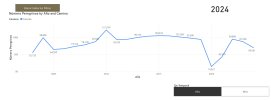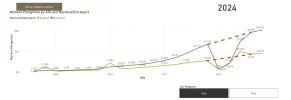Throwing my two cents (well, maybe three cents) into this discussion, it occurs to me that, one of the other, intangible reasons, why the number of daily Compostelas issued is up dramatically, is that the process for generating a Compostela was partially automated as from 2022. Pilgrims now pre-submit all their data electronically, to the pilgrim website, before arriving at Santiago de Compostela.
This eliminated clipboards, paper forms and shared pens - as disease vectors at the time. It also avoids the time needed waiting at the counter for a staff-person or volunteer to key input each pilgrim's handwritten information. As a single step, eliminating only the manual data entry at the counter reduced the per-pilgrim transaction time from around 6 to 7 minutes to around two minutes, per pilgrim.
As a regular volunteer, since 2014, I clocked these process times myself, in-person, in 2021 and 2022. A family illness and my need to remain here as caregiver precluded me from volunteering in 2023 and 2024. However, I continue to follow progress remotely, via direct reports from friends who work at the Pilgrim Office. Saving five-minutes on every pilgrim adds up fast, especially in July and August. The time saved is accumulative. The results have been dramatic.
At the same time, Compostela variants provided were reduced to one type. These pre-printed certificates are over-printed on a laser printer, taking input from the electronically submitted personal information, resulting in excellent quality every time. The Certificate of Distance is also printed on the same laser printers. Streamlining the process, and reducing the certificate variants issued, greatly reduced the overall waiting time.
As a result, the total time to arrive, enter and receive a Compostela can be measured in minutes rather than the previous hours. Once the Pilgrim Office reduced the overall wait at the office, from two to three hours, to perhaps 30 minutes start to finish, it likely has had a magnet affect, inducing more arriving pilgrims to request Compostelas.
Formerly, a LOT of arriving pilgrims would not bother seeking a Compostela, because of the time investment required. So, mathematically, and in my view, part of the large increase in Compostela numbers may be due to a reduction in "self refusals" to seek a Compostela because of the wait time. Per the available statistics, this would be reflected across all Camino routes, times of year, and demographics.
To be sure, the annual volume of pilgrims is most assuredly up overall in recent years, after the COVID pandemic. But, trying to get an accurate volume projection based solely on the number of Compostelas issued is difficult because of the variables involved. The reduction in the "self-refusal" rate on arrival is but one such variable.
I only wish there was a cost-effective way to refine this estimate. But, lacking the ability to "look back" over the previous years, there are very few constants that we can rely to interpolate the trends.
Unless I miss the point of interest here, the only historical data that might be reliable enough to infer a percentage change in the number of pilgrims on any Camino route are the
departure stats coming out of the Pilgrim Office at St. Jean Pied de Port. In my experience, this is the only place that is both a "choke point" and is set-in-place over history. It is also the only place of which I am aware, that has counted the same statistic - the number of pilgrims starting from a fixed Camino starting point for decades.
Yes, the
Camino Frances is only one of dozens of Camino routes. But, as a statistical sample, if 47 percent of ALL pilgrims eventually arriving at Santiago de Compostela arrive from the
Camino Frances, the sample size is adequate to be significant. IMHO this is true, even if you discount the large tranche of folks who start at Sarria, or at intermediate places: Logroño, Burgos, Leon, Astrgra, Ponferrada, etc.
The remaining number of people who arrive off the Frances, having started at St. Jean Pied de Port, remains statistically significant. Measuring the CHANGE in THAT variable would go a long way towards Inferring whether and to what degree the number of pilgrims is increasing. It would at least give us a RATE of change.
I propose that extrapolating this rate of change across other Camino Routes would be reasonable and appropriate.
At least, this makes sense to me - I think. Hope this helps the dialog.
Tom






















